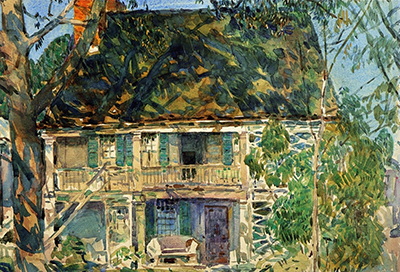 Buy Art Prints Now
Buy Art Prints Nowfrom Amazon
* As an Amazon Associate, and partner with Google Adsense and Ezoic, I earn from qualifying purchases.
The Brush House is a 1916 watercolour painting by American artist, Childe Hassam. It is today to be found within the collection of The Metropolitan Museum of Art in New York, USA.
The straight forward composition focuses on a charming house which fills pretty much the entire dimensions of the painting, other than for a tall tree in the foreground. This upbeat work brings large amounts of sunshine into the design, which brightens the facade of the house itself. The tree is then used to add shade across parts of the building which creates an interesting contrast and allows the artist to vary his tones much more. To the right hand side is a much slimmer tree with bushy growth and this reaches up to about halfway up the building, because of the impact of perspective. The Brush House is likely to have been completed fairly briskly, as was the way with watercolours and the artist himself is known to have worked with watercolours from an early point in his career, well before he even started to experiment with oils. The medium is also more easily transported around, with small boxes of watercolours and a sketchbook, allowing him to travel around making new work outdoors when he wished to.
The painting is sized at 15 5/16 x 22 5/16 in, making it quite possible that it was originally part of a sketchbook, before being removed and sold separately. The gallery who own it today purchased it back in 1917, just a year after the artist had finished it, making it likely that The Metropolitan Museum of Art purchased it directly from Hassam himself. The location of the house in this painting is believed to be in Cos Cob, Connecticut, where the artist spent time in the company of other artists. He loved the local architecture style and found that it complemented his Impressionist style particularly well. There would be old houses such as this, plus agricultural out buildings such as barns which could inspire his work. It is believed that the house pictured here has now been converted into a museum to mark its own role in encouraging the visual and written arts for a good few decades. Whilst being relatively simple in terms of layout, this painting does feature a wealth of detail, capturing each and every architectural feature of the front of the Brush House.
Architecture would play an important part in his work, both from the inside and outside. He loved cityscapes with huge structures which would line each side of his paintings, whilst tiny figures walked around below. Whilst in rural areas, though, he would focus on more of the detail of each building and often just tackle one per artwork, as seen here as well as in The Church at Gloucester. He travelled extensively across the US in search of new ideas for his work and managed to perfect the balance between French influences on his techniques, but with American content to suit his local audience. He produced and sold thousands of paintings across his lifetime, including both oils and watercolours. He also used lithographs to bring extra income in, and can be considered a commercially successful artist.



